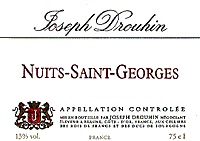Joseph Drouhin, Nuits-Saint-Georges (Burgundy, France) 2010 (Dreyfus, Ashby & Company, $63): If you enjoy reading about wine, you have probably encountered more than a couple of articles over the past 18 months about the 2010 vintage in Burgundy. It is an improbably successful vintage, you would have read, because the flowering was poor and the summer cool and wet. But the small harvest produced high-quality red (and white) wines that over-deliver on drinking pleasure.
and the summer cool and wet. But the small harvest produced high-quality red (and white) wines that over-deliver on drinking pleasure.
I recently had the opportunity to pop the corks on a quartet of 2010 Burgundies that shared the theme of being from the same commune –Nuits-Saint-Georges — and the same producer —–Joseph Drouhin. To say that tasting those wines was an exercise in pleasure is a huge understatement.
The Joseph Drouhin house is one of the most established names in Burgundy, well-known as both a négociant company and as a domaine producer, with vineyard holdings in Chablis, the Cotes de Nuits and the Cote de Beaune. In the commune of Nuits-Saint-Georges, Drouhin produces a village-level wine and three premier cru wines. Two of the premier cru wines, Damodes and Cailles, are new to the Joseph Drouhin repertoire in 2010, while the third, Procès, is part of the family so to speak: Laurent Drouhin owns nearly an acre of the Les Procès site, which is almost half of that premier cru vineyard.
For this column, I chose to feature the basic village level wine because its production is considerably larger than that of the premier cru wines, and you stand a much better chance of being able to find it. In 2010, grape yields were very low (due to that poor flowering and cool summer) and wine quantities are small. Only about 200 cases of the Joseph Drouhin Nuits-Saint-Georges 2010 came to the U.S. — but only 30 to 50 cases of each of the 2010 Nuits-Saint-Georges premier cru wines arrived here. Availability aside, the village-level wine is also delightful.
The personality of this wine is fresh, vibrant and racy, characteristic of a cool vintage. Tannins are very fine and unobtrusive, fruit character is vivid and pure, and acidity is tensile. Aromas and flavors suggest red fruits more than black fruits — tart red cherry, raspberry, strawberry — with spicy and minerally notes. The wine shows excellent mid-palate depth and good concentration of fruit, both hallmarks of quality. Although it is thoroughly enjoyable now, this wine has the concentration and structure to improve over the next few years, in my opinion, gaining in complexity.
The three premier cru wines, each $102 suggested retail, share the freshness, vibrancy and supple tannins of the village-level Nuits-Saint-Georges, but they up the ante in weight and richness. My favorite of the three, the Cailles, is the roundest, softest and most polished, very attractive now and yet it seems to have latent charms yet to be revealed, showing the most potential for development. The Procès is the most textured, fleshy and plump with slightly darker fruit notes and balsam nuances, a rich wine that clearly will shine with additional age and yet in its richness is very approachable now. The Damodes shows more focus of flavor and precision than Procès, and is edgier than Cailles, with delicacy, succulence, silkiness and a remarkable finish — a real charmer. Certainly each of these three wines will have its fans; for example, my fellow taster preferred the Damodes, because of its delicacy.
But even against the backdrop of these three premier cru wines, the village-level Nuits-Saint-Georges is an impressive wine. It showcases the freshness of the 2010 vintage, the special fruit-acid-tannin balance of the vintage, with the spiciness and structure typical of Nuits-Saint-Georges.
91 Points
